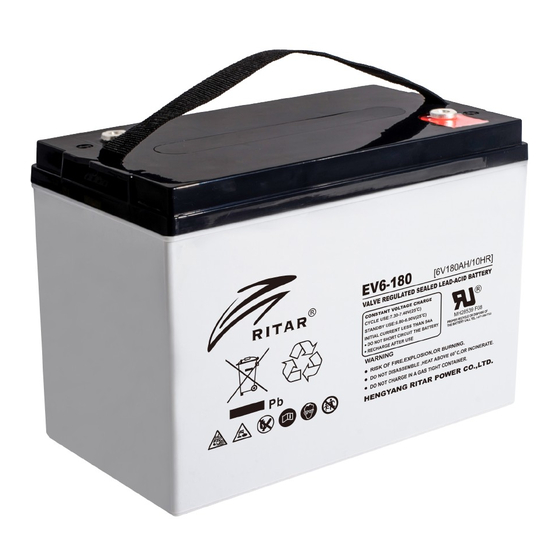
Advertisement
Advertisement
Table of Contents

Summary of Contents for RITAR RA Series
- Page 1 RITAR INTERNATIONNAL GROUP LIMITED Technical Manual RA Series VRLA Battery...
-
Page 2: Storage Before Installation
Prolegomenon In order to install and use RA series battery correctly and safely, please read this technical manual and other data together with battery carefully for a comprehensive understanding. ★Pay attention to safety during installation to avoid accident. ★It is required for users to read this manual carefully and keep it well. -
Page 3: Installation Cautions
4.Low Self Discharge Because of the use of lead-calcium grids alloy, RITAR batteries have low self discharge and reliable performance. In room temperature, self discharge ratio per month of RITAR battery is about 3% of the battery capacity. -
Page 4: Working Principle
After completion of battery installation, danger warning should be posted at prominent position to prevent safety accidents. Notice: 1. RA series batteries are starved electrolyte batteries and shall not be inverted. Vertical Inverted 2. The battery bank must be of the same brand and model. -
Page 5: Maintenance
(lead sulfate→dioxide alumina) (lead sulfate→sponge lead) ( dioxide alumina→lead sulfate) (sponge lead→lead sulfate) ( → sulfuric acid water , proportion decrease) (water → sulfuric acid, proportion rise) Record The operating record of stationary batteries is very important for battery maintenance and protection. This information is useful for users to confirm battery life and adjust the longevity. - Page 6 1.Inspection Try to make all inspection under float charging conditions. Inspection should be conducted according to instruction manual from the supplier and record all test data for future collation. 1.1 Monthly inspection General inspection items and record of every month are as follows: 1.1.1 Float charging voltage of all batteries.
-
Page 7: Common Faults & Solutions
Common Faults & Solutions Common Faults Solutions Acid leakage Please contact the supplier for solutions. Please contact the supplier for solutions. Crack After 24-48hrs equalization charger, still low, Low floating voltage of single cell lease contact the supplier for solutions High temperature on Check whether the connection is good, battery pole and cell...



Need help?
Do you have a question about the RA Series and is the answer not in the manual?
Questions and answers